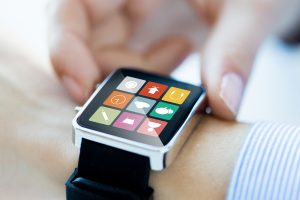Smart materials have the potential to be infused into just about everything on or around us — our bodies, houses, cars, buildings and cities. Smart garments and e-textiles (which are a medley of traditional fabrics with cutting-edge technology) are transforming fashion, apparel, retail and furnishing sectors.
While the methods for incorporating the technology vary (for example, placing sensors into a compression t-shirt or weaving special fibers into a dress), these fabrics not only allow an individual to enjoy cutting-edge style, but also harness the abilities of IoT. The potential of smart fabrics, which can communicate with smartphones to process biometric information such as heart rate, temperature, breathing, stress, movement, acceleration, or even hormone levels, promise a new era for the retail sector.
Clothing is the ultimate wearable medium as compared to a wristband and can track more biometric signals due to the surface area covered by them. Thus biometric tracking becomes easier and significantly more accurate.

Smart garments and e-textiles have diverse uses, from the utilitarian (measuring your heart rate) to the uber cool (light-up shirts). The so-called “Smart Clothes” are garments characterized by traditional protective and representative functions in combination with digital and technical features. This is considered a promising opportunity for one of the world’s largest economic sectors – the fashion industry.
Take a sneak peek into a few real-world possibilities of smart clothes:
- Misplaced your coat? No problem…lets track it.
- Need to charge your smart phone? Put it in your pocket and your pants act as a charger.
- Need to track stress levels….your bandana tells you to do 10 mins of meditation in order to feel more relaxed.
- Feeling cold…how about setting the temperature of your jacket to 70 degrees Fahrenheit.
- Or wear the cooling vests which lower the body temperature to activate the brown fat. When brown fat burns, it creates heat without shivering. This process is called thermogenesis. During this process, the brown fat also burns calories. Brown fat is highly regarded as a possible treatment for obesity and some metabolic syndromes.
- Get your sleeves rolling with electrocardiogram (ECG) technology to monitor heart rate activity. Special sleeve modules even have sensors on board to monitor body temperature, air quality and UV rays.
- Let your bikini tell you it’s time to get out of the sun or apply more sunscreen. Since you entered your skin type in the companion iOS or Android smartphone app and its monitoring the UV levels you are exposed to during the day.
- Any takers for Smart shirts which can track sporty metrics including intensity and recovery, fatigue level, calories burnt and sleep quality….and athletes go – “yes, of course”!!
- Smart socks that detect stride and provide data on heel strike, pronation and tell you when it’s time to replace your shoes….what we really also hope is they have special sensors which can always make them smell fresh like roses. High hopes…ehh?
- Last but not the least are trackable children’s t-shirts. Fitted with GPS sensors and trackable through an app on the phone. Isn’t that the number one stress parents go through, especially when the little ones are out on their own or the fear of losing them in crowded places?
Communication Aspect
While the focus is mainly on connection of clothes with the wearer’s body, smart garments have the capability of communicating with the immediate environment. By means of integrated transmitters, a smart garment can be identified and contacted individually. A basketball match jersey could easily become the ticket to the match in the stadium and enable the wearer to pre-order VIP seating or drinks.
The novel paradigm of ‘Internet of Smart Clothing’ envisions a world where smart clothes communicate with each other, with the objects in their environment and with remote servers on the Internet in order to provide advanced services.

IoT Garments – Win-Win for all
More than 15 million tons of used textile waste is generated each year in the United States, and the amount has doubled over the last 20 years.
An average American throws away approximately 80 pounds of used clothing per person, per year. On average nationally, it costs cities $45 per ton to dispose of old clothing.
The So-called “fast fashion” trend can bear at least some of the blame for America’s stuffed closets.
Textiles and clothes recycling is a beneficial activity from environmental, social and economic points of view, as opposed to landfilling or being used for energy. As cities increasingly divert other high-volume waste streams such as organics, the recycling of old clothes has been called the next frontier for cities looking to reduce solid waste.
Can Smart Clothing help in easing the landfill pressure?
Can IoT Garments result in benefits not just for the consumer but also assist in averting America’s clothing crisis?
With the advent of smart phones and smart watches, a lot of people started to spend less on traditional watches and rely more on just their smartphone and/or smartwatch for their needs. The regular watch will always be a fashion accessory and/or a luxury item but a lot of watch aficionados may not be really buying a whole lot of new watches. It just helps that the smart watches are trendy and make a statement too.
on traditional watches and rely more on just their smartphone and/or smartwatch for their needs. The regular watch will always be a fashion accessory and/or a luxury item but a lot of watch aficionados may not be really buying a whole lot of new watches. It just helps that the smart watches are trendy and make a statement too.
If the same logic was to be applied to garments and if a smart garment could do a whole lot more than a regular garment, the need to buy more regular stuff can curb our sartorial appetite under certain circumstances. It’s debatable as certain sections believe that the need to buy fashionable clothes has a different objective altogether and it is not driven by need but wants. So no amount of smart garments can really stop the person from chasing the new trends.
There is no point in changing everyone. The point is to start somewhere.
The whole point is to make the smart garments tick on all aspects in order to become more mainstream. Technology wise – they should be comfortable, batteries should last long enough, as well as being safe and flexible enough to adapt to body movements. They need be trendy and not compromise on aesthetics. To build and maintain an emotional connection with the customer and be competitive, IoT actors in the fashion industry should seek compelling experiences and services combined with tasteful designs and fitting digital business models.
The time is not far when products will have unique digital identities and data profiles in the cloud and thus enabling us to find our favorite “Brand XYZ Chambray shirt 005” when we’ve lost it. Near Field Communication (NFC) technology gives a unique, non-transferrable identity to each item, enabling brands to deliver value-added services that help drive revenue growth and loyalty, while also gathering customer intelligence. Billions of clothing items having digital capability is a reality waiting to happen.
The clothing revolution is here….are you ready to connect?


Would you like to share your thoughts?